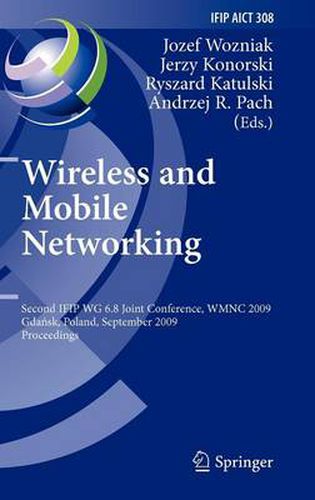Readings Newsletter
Become a Readings Member to make your shopping experience even easier.
Sign in or sign up for free!
You’re not far away from qualifying for FREE standard shipping within Australia
You’ve qualified for FREE standard shipping within Australia
The cart is loading…






This title is printed to order. This book may have been self-published. If so, we cannot guarantee the quality of the content. In the main most books will have gone through the editing process however some may not. We therefore suggest that you be aware of this before ordering this book. If in doubt check either the author or publisher’s details as we are unable to accept any returns unless they are faulty. Please contact us if you have any questions.
Recent spectacular achievements in wireless, mobile, and sensor networks have dramatically changed our lives in many ways. However, the rapid evolution of wireless systems not only promises increased functionality, reliability, availability, and security, as well as putting a wide variety of new services at the users’ disposal ? it also creates a number of design challenges that our research community is now facing. Scientists and engineers need to come up with, and promptly implement, novel wireless network architectures, while system operators and planners rethink their business models and attend to the growing expectations of their customer base. To provide a suitable forum for discussion between researchers, practitioners, and industry representatives interested in new developments in the respective research area, IFIP WG 6. 8 launched three separate series of conferences: MWCN (Mobile and Wireless Communications Networks), PWC (Personal Wireless Communications), and WSAN (Wireless Sensor and Actors Networks). In 2008, MWCN and PWC were merged into the IFIP Wireless and Mobile Networking Conference (WMNC 2008), held in Toulouse, France, from September 30 to October 2, 2008. MWNC 2008 and PWC 2008 topics were subsequently revised with a view to covering the whole spectrum of hot issues in wireless and mobile networking. As a result, IFIP WG 6. 8 decided to add WSAN as another WMNC track.
$9.00 standard shipping within Australia
FREE standard shipping within Australia for orders over $100.00
Express & International shipping calculated at checkout
This title is printed to order. This book may have been self-published. If so, we cannot guarantee the quality of the content. In the main most books will have gone through the editing process however some may not. We therefore suggest that you be aware of this before ordering this book. If in doubt check either the author or publisher’s details as we are unable to accept any returns unless they are faulty. Please contact us if you have any questions.
Recent spectacular achievements in wireless, mobile, and sensor networks have dramatically changed our lives in many ways. However, the rapid evolution of wireless systems not only promises increased functionality, reliability, availability, and security, as well as putting a wide variety of new services at the users’ disposal ? it also creates a number of design challenges that our research community is now facing. Scientists and engineers need to come up with, and promptly implement, novel wireless network architectures, while system operators and planners rethink their business models and attend to the growing expectations of their customer base. To provide a suitable forum for discussion between researchers, practitioners, and industry representatives interested in new developments in the respective research area, IFIP WG 6. 8 launched three separate series of conferences: MWCN (Mobile and Wireless Communications Networks), PWC (Personal Wireless Communications), and WSAN (Wireless Sensor and Actors Networks). In 2008, MWCN and PWC were merged into the IFIP Wireless and Mobile Networking Conference (WMNC 2008), held in Toulouse, France, from September 30 to October 2, 2008. MWNC 2008 and PWC 2008 topics were subsequently revised with a view to covering the whole spectrum of hot issues in wireless and mobile networking. As a result, IFIP WG 6. 8 decided to add WSAN as another WMNC track.